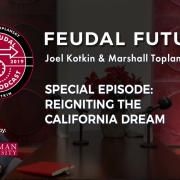God and the Pandemic
If God gives you technology, use it to reach people!
~Rabbi David Eliezrie The Secret of Chabad
During this most miserable of years, religion, like virtually every major social institution, has been profoundly disrupted. There have been church closures and the ranks of outdoor—or socially distanced—worshipers represent a mere fraction of those who engaged before. Yet the pandemic may also mark a critical breaking point, leading to profound changes in how spirituality is experienced and sustained. In some senses, we are witnessing a shift as important as that brought about by Guttenberg’s press and Luther’s vernacular Bible during the Reformation. As sociologist and historian Max Weber suggested, these developments overturned the notion that “magic and the supernatural quest for salvation” belonged to the Latin-speaking priesthood. The pandemic and the flood of new online spiritual offerings have combined to transform religious life in much the same way.
This will be a disruptive and painful transition for many established religious institutions; empty pews and church closures augur what Fordham’s David Gibson has called a “religious recession.” COVID-19 restrictions, some research suggests, could end up eliminating five percent of America’s churches this year, particularly smaller congregations, particularly in poor, rural, or remote areas. But Gibson points out that other commentators believe that the current disruption is more likely to usher in an era of religious reawakening and revival in which people reject organized faiths but maintain some spiritual values. Today, fewer people than ever attend church, but two-thirds of unaffiliated Americans polled by Pew still believe in God or some kind of “universal spirit.” Increasingly, these searchers address their spiritual needs online, at home, and through specific programs.
Religion and periods of social stress
Although hardly as lethal as the ancient plagues, the current pandemic has taken an enormous toll on our sense of wellbeing. Gallup reports the highest levels of mental anguish for 20 years in the United States, a phenomenon also evident in the United Kingdom and Europe. Yet, historically, religions have expanded during periods of extreme stress, a trend that provides grounds for a spiritual rebirth. As church attendance has plummeted—two-thirds of US Protestant churches have suffered a decline this year of 50 percent or more—virtual church attendance is booming. According to Pew, a quarter of Americans say the pandemic has bolstered their faith, a finding confirmed by Gallup. Today, many online churches are flourishing, some with as many as 70,000 virtual attendees. Google searches for “prayer” and “Christianity” have “skyrocketed,” not only in the US but around the world. Danish researcher Jeanet Sinding Bentzen found requests for religious sources and prayers has grown dramatically, even in heavily secularized Europe. Similarly, one of the UK’s largest online Christian bookstores, Eden, saw physical Bible sales rise by 55 percent in April.
This reprises past experience. During the plague-ridden days of the late Roman Empire, Christianity gained over pagan cultures by offering counsel, comfort, and philosophical explanations. Historian William McNeill speaks of the “sublime capacity” of the early Christian to cope with plagues and offer hope that was critical to the Church’s rise. Those making the transition tend to be focused on addressing the pandemic-caused dilemmas faced by the vast majority of people. The evangelical group Global Media Outreach has gone from reaching 350,000 people per day to upwards of 500,000 globally. A GMO leader told the Christian Post, “People are coming to us saying, ‘I need hope. Where can I find hope in the face of tragedy, anxiety, bankruptcy?’” He added, “When people are in pain, we offer encouragement and hope. They’re coming to us looking for answers.”
The de-establishment
For many established religious institutions, the pandemic threatens to exacerbate an ongoing retreat from organized religion. This applies not only to Europe, where well over 50 percent of those under the age of 40 do not identify with any religion, but also in the United States, considered the most religious of high-income countries, where almost 40 percent of people aged 18–29 now claim no religious affiliation. This erosion among the faithful has weakened the financial strength of religious institutions of all kinds, including even the mighty Vatican. One-in-three US congregations has no savings, according to the 2018–2019 National Congregations Study, an ongoing survey conducted at Duke University Divinity School. Just 18 percent have a year’s cushion. In Minneapolis, local churches have taken the hit, and poorer ones have shown a 70 percent decline in donations. Many of these, notes Florida-based religious consultant Brock Gant, “are not prepared with technology. Some are simply giving up and many will be gone.”
Read the rest of this piece at Quillette.
Joel Kotkin is the author of The Coming of Neo-Feudalism: A Warning to the Global Middle Class. He is the Presidential Fellow in Urban Futures at Chapman University and Executive Director for Urban Reform Institute. Learn more at joelkotkin.com and follow him on Twitter @joelkotkin.






 Paul Farmer, republished under CC 2.0 License
Paul Farmer, republished under CC 2.0 License

